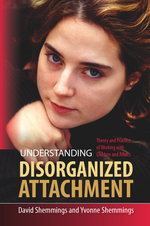 David Shemmings is Professor of Social Work in the School of Social Policy, Sociology and Social Research at the University of Kent, UK. Yvonne Shemmings is a qualified social worker and Continuing Professional Development Specialist, and has trained professionals in over 30 child protection organizations.
David Shemmings is Professor of Social Work in the School of Social Policy, Sociology and Social Research at the University of Kent, UK. Yvonne Shemmings is a qualified social worker and Continuing Professional Development Specialist, and has trained professionals in over 30 child protection organizations.
Here, they answer some questions about their new book, Understanding Disorganized Attachment: Theory and Practice for Working with Children and Adults.
Tell us about yourselves and how the book came about.
We each bring different experience to this book. Yvonne worked in child protection for many years, initially as a social worker and then as a supervisor and manager. For the past 15 years she has been training child protection professionals from each of the key agencies. David worked for some years with severely traumatised and abused children before becoming a senior manager in social services. He has been an academic now for nearly 25 years and has worked in three universities in the UK – University of East Anglia, Middlesex and, latterly, Kent – concentrating on child protection and welfare.
 We wrote the book because we were concerned about the gaps in our ability to predict confidently when a child is being abused or neglected. Although child protection professionals help keep many children safe – and it’s important to remember that the UK has one of the lowest rates of child homicide at the hands of their carers – nevertheless, they sometimes bring the wrong families into the system while missing others – not because they lack skill but as a result of gaps in our knowledge about what leads to maltreatment. In its simplest terms, we over-concentrate on the lifestyle of the caregivers but overlook key factors explaining why some parents who take drugs, who have mental health problems, who were abused as children, who are single parents, etc., abuse their child/ren … while, clearly, others do not. Our review of the research showed us convincingly that the most accurate and reliable way of assessing whether a child is being maltreated is the presence of disorganised attachment in their behaviour.
We wrote the book because we were concerned about the gaps in our ability to predict confidently when a child is being abused or neglected. Although child protection professionals help keep many children safe – and it’s important to remember that the UK has one of the lowest rates of child homicide at the hands of their carers – nevertheless, they sometimes bring the wrong families into the system while missing others – not because they lack skill but as a result of gaps in our knowledge about what leads to maltreatment. In its simplest terms, we over-concentrate on the lifestyle of the caregivers but overlook key factors explaining why some parents who take drugs, who have mental health problems, who were abused as children, who are single parents, etc., abuse their child/ren … while, clearly, others do not. Our review of the research showed us convincingly that the most accurate and reliable way of assessing whether a child is being maltreated is the presence of disorganised attachment in their behaviour.
The book helps child protection professionals understand precisely what is going on when a child experiences disorganized attachment (DA). Without that understanding, practitioners are likely to misinterpret behaviours and contexts. Attachment theory and research have come a long way since the early pioneers began their quest to understand why good – but particularly ‘not so good’ – parenting can have such a profound effect on how we develop as children and later as adults. But it is the recent research on neurology, biochemistry and their implications for attachment that help child protection practitioners because the insights shift their focus back to relationships, rather than ‘form-filling’.
What is disorganized attachment and why is it considered to be the ‘most extreme form of insecure attachment’?
Mary Main evocatively called DA ‘fear without solution’: it occurs when a child is simultaneously frightened in a situation into which a caregiver enters. For example, if a toddler is in a room on their own or with a stranger they will usually protest by crying. For most children, the appearance of their caregiver usually provides comfort and a safe haven to go to. But what if the caregiver is the source of danger, apprehension or dread? Then the child is faced with an unsolvable dilemma: ‘I’m scared in the room … but I’m more frightened of my caregiver’. What happens is that the child freezes. They fall on the floor, or walk towards the caregiver but with their head turned the other way. In older children DA behaviour becomes apparent if they are asked to complete an attachment-related story or reflect upon their relationships with their caregivers.
We argue that too much attention is often paid in social work to ‘insecure attachment’. But so many studies now indicate that, if a large enough sample is taken, about 40% of children (and adults) are insecurely attached. This relative proportion applies across cultures (although members of different cultures will ‘show’ their insecurity differently). The point is that insecurely attached people have an organised strategy to deal with anxiety; they just have different ways of dealing with their emotion. Children who are maltreated do not have an organised way of reducing the stress; that is why DA is the most extreme form of insecurity.
What kinds of interventions work best with children and adolescents who suffer disorganized attachment?
It depends on whether the plan is for the child to remain with their carers or to be found an alternative placement. If the child is going to stay with its carers then the intervention needs to focus on the carers, not the child. The preparation for placement with a child should seek to raise the foster carer’s and adopter’s awareness of about how DA operates, and under what circumstances, otherwise they will quickly be caught off-guard. Additionally, there are a number of initiatives being set up in schools – such as Nurture Groups and the Roots of Empathy – which have been shown to increase significantly children’s opportunities for secure base experiences. But if the child continues to live with maltreating adult/s the work must address the abusive parenting.
What work can and should be done with their neglectful, often abusive parents?
There is a growing amount of research indicating strongly that chronically maltreating caregivers do not respond well in the medium- or long-term to approaches which are exclusively cognitive in their approach. Such interventions are effective with many families but have only limited impact with highly resistant and chronically abusive caregivers. It is thought that such parents almost need a kind of ‘re-parenting’ themselves, before they can offer sensitive care to their child/ren.
But we are now a lot clearer about the form such re-parenting needs to take: it has to include large elements of what is called ‘mentalised experience’ when they are watching videos of themselves parenting their own child. The worker ‘speaks for the child’ while providing the parent with lots of empathy, compassion and understanding (the intervention is designed in such a way as to increase the likelihood that positive interactions are observed). The best example of this approach, which we give an example of in the book, is the Video-based Intervention for Positive Parenting (VIPP), first developed at Leiden University in the Netherlands. Quite dramatic results can be observed after 4-6 sessions of 1.5 hours.
How might your book inform child protection practice and services?
It does this in at least three ways. Firstly, readers are introduced to the latest research on the ‘neuropsychology of attachment and maltreatment’; we do this in an accessible, non-technical way because we understand that child protection professionals are busy people who are much more likely to engage with evidence-based research when it is easy to read and digest.
Secondly, we include practice-related and relevant examples to illustrate the theoretical material outlined; we have found over the years that child protection practitioners and their supervisors like re-visiting theory if it is presented in the right way.
Thirdly, we include three chapters each of which is co-authored by practitioners involved in our innovative Assessment of Disorganised Attachment and Maltreatment (ADAM) Project, currently being implemented in London and other parts of Europe. We have now trained over 200 professionals to use our Maltreatment Pathway model and their feedback has been extremely positive and enthusiastic. Their overall reaction is an unequivocal ‘thumbs-up’ for the increased confidence they experience in the quality of their assessments, both in court as well as within child protection procedures more generally.
Copyright © Jessica Kingsley Publishers 2011.
I will be buying this book as a psychotherapist working with adults with attachment disorders. It is only the past 15 years or so that disorganised patterns of insecure attachment have been made sense of. David Howe has written some excellent material on this subject.
Whilst I appreciate that this book is geared towards those in child protection and social work, working with quite disturbed children and adolescents. It is my own personal experience and work with adults which has made me realise that disorganised attachment is actually often found when children are not only frightened of their supposed caregivers, but also frighened for them. Either way, the source of their anxiety is the very person who is meant to be the antidote.
For example if a mother is in an abusive relationship, the child can be as frightened of her for being overwhelmed as a parent who blatantly poses a threat to his/her safety.
This is the root of codependent patterns of behaviour, so often written about. Where the child seeks to preserve the ‘good’ parent to cope with intolerable anxiety i.e. anxiety without end.
So, frightened of and frightened for. Homily aside, any addition to the literature which helps provide therapeutic insight is a must read. Bit baffled by the picture of the model on the front of the book though?
Thanks Mark – these are perceptive comments!
We do discuss the difference between ‘frightened of’/’frightened for’ parenting behaviour as well as the differences between DA and attachment disorders, so I’m glad you’ve highlighted these points.
David Howe does write so well about DA (but I would say that, as he was my PhD supervisor!) Hope you enjoy the book – do keep channels open. Best wishes .